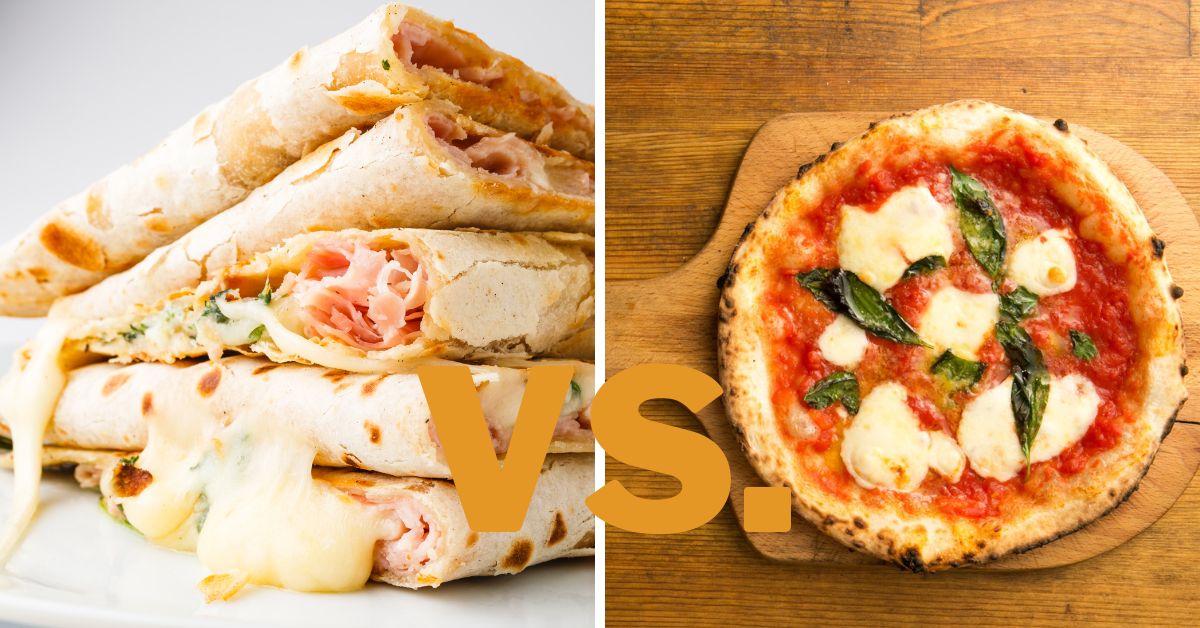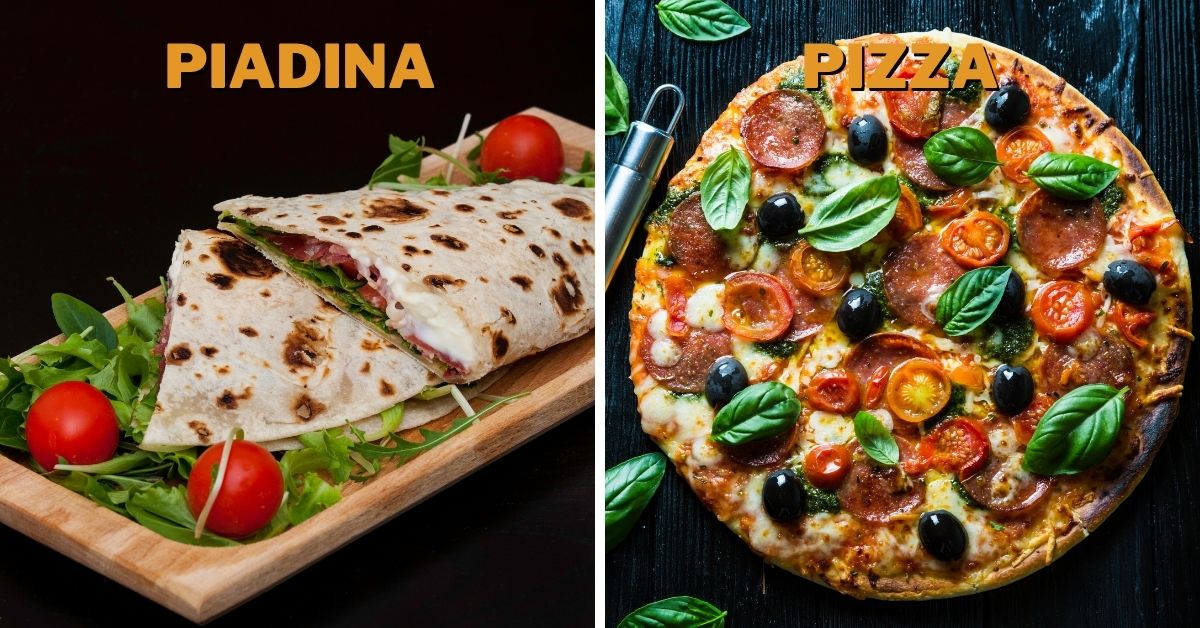Piadina vs. Pizza: Differences & Uses

Both piadina and pizza are dishes originating in Italian cuisine and have since become popular in other parts of the world. They both utilize a type of flatbread, on top of which you put various ingredients. But is that where the similarities stop between them?
Piadina is a type of flatbread used as a wrap, while pizzas are leavened flatbread with various toppings. Crucially, pizzas utilize yeast and other leavening agents, while piadina usually does not. Pizzas are traditionally made in an oven, whereas piadina is grilled on a stove.
For the purposes of this comparison, we are going to look at both piadina and pizza in more detail. We will discuss their origins, methods of preparation, look and size, variations, popularity worldwide, etc.
Piadina vs. Pizza: Differences
Before we explain differences in detail, take a look at a cheat sheet to help yourself.
| Features | Piadina | Pizza |
|---|---|---|
| Origin | Romagna, Italy | Naples, Italy |
| Size | 8-10 inches | 6, 8, 10, 12, 16 inches |
| Cooking Method | Grilled on a stove | Oven-baked |
| Leaving Agent | Usually no | Always uses yeast |
| Serving | Folded in half | Not folded |
| Variations | No variations | Numerous variations; deep-dish, New York style, Neapolitan, etc. |
Origins
Both piadina and pizza have their roots in Italian cuisine. To be more precise, piadina first became popular in the Romagna region of Italy, which includes the cities of Forti, Rimini, Ravenna, and Cesena. The first recorded history of a piadina recipe dates back to 1371.
Pizza also hails from the country of Italy. Although similar flatbreads with various toppings can be found in ancient Greek, Roman, and Egyptian cuisine, the birthplace of modern pizza is widely regarded as the city of Naples in southern Italy.
Ingredients
The basic ingredients for any piadina include flour, water, salt, and a source of fat. Historically, people used lard. But nowadays, people mostly prefer using olive oil.
Piadina is usually unleavened, so it does not use yeast. But sometimes, people use a bit of baking soda for a softer texture. This differs from pizzas, as pizzas typically utilize yeast and/or other leavening agents.
Pizza dough has a few different iterations depending on the specific style of pizza. But they all have four basic elements – flour, water, yeast, and salt. Some versions of pizza utilize olive oil, similar to piadina. But that is occasional instead of being the standard.
Another distinctive element in a pizza dough is yeast. This is what will give your pizza a lift. Some recipes also call for additional leaving agents for a puffier crust.
Appearance
You can easily tell the two types of bread apart just by looking at them. Piadina is much flatter and thinner than most pizza bread. Additionally, pizza tends to be of a darker color due to the heat in the oven. Because piadina is grilled on a stovetop, they end up with a lighter complexion.
Another easy distinction you can make is from the presentation. Piadina is always folded in half to form a semicircle. In this way, a piadina looks more like a quesadilla than a pizza. Pizza has its toppings out there for all to see. In a piadina, the other ingredients are sandwiched between the bread.
Pizza tends to rise more in the oven thanks to the use of yeast, which acts as a leavening agent. Piadina does not get that big even if you use baking soda to make it.

Preparation
Making pizza is a significantly more complicated task than making piadina. Different pizza styles will specify different ratios of water to flour, different levels of gluten development, and different types of flour.
In contrast, piadina is not all that specific or sensitive. And the addition of fat gives piadinas a richer and flakier texture.
Another distinction comes in their method of baking. Pizzas are baked in an oven. Traditionally, stone ovens are used for making pizzas. But people at home can also make them with convection and microwave ovens.
Piadina, on the other hand, is typically made on the stove. Traditionally, people used to grill them on unglazed terra cotta stones. But in modern times, a cast iron skillet or griddle gets the job done.
Variations
Pizza is perhaps one of the most varied food items in the world, with so many regions coming up with their own versions of this iconic fast food. You have Neapolitan pizza, Chicago-style pizza, New York-style pizza, etc. Depending on how big the crust is, you have flatbread pizzas, deep-dish pizzas, thin crust pizzas, stuffed-crust pizzas, and so many more.
In contrast, piadinas are a much simpler form of food. The actual flatbread is made the same way throughout different regions. The filling that goes inside the bread is thing that varies.
Size
Typically, piadinas are 8 to 10 inches in diameter. So, they are just bigger than a regular taco. Pizzas, however, have a more varied range of shapes. A personal pizza, which is meant for a single person, can be 6 or 8 inches. A pizza for 2-3 people is 12 inches long. And you can get even bigger with a family-sized pizza that can stretch up to 16 inches or more.
Uses
Piadina is used as a wrap for different types of filling. In contrast, pizza bread serves as a base for various toppings.
Popularity
In terms of popularity, pizzas are much more widespread compared to piadinas. Pretty much any culture that has a fast food industry invariably has pizza on its menu. Its popularity also explains why there are so many iterations of the basic formula.
Piadinas are much less well-known in comparison. They are famous in their country of origin. But outside of Italy, piadina is not as typical.
Is Piadina Just a Folded Pizza?
Piadina is not merely a folded pizza. They are their own dish. Recently, Papa John’s introduced a new item on their menu: a folded pizza. And the inspiration behind this item is the Italian piadina.
But piadina and pizza are not the same types of food. They are made from different ingredients and with different methods.
To conclude, piadina and pizzas have established a place in Italian cuisine. They are two different flatbread dishes but often with similarly delicious results.
